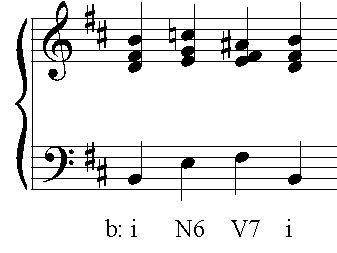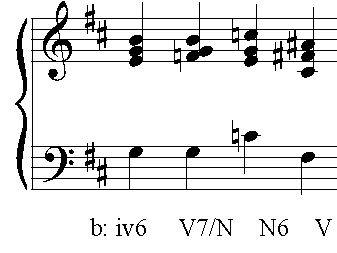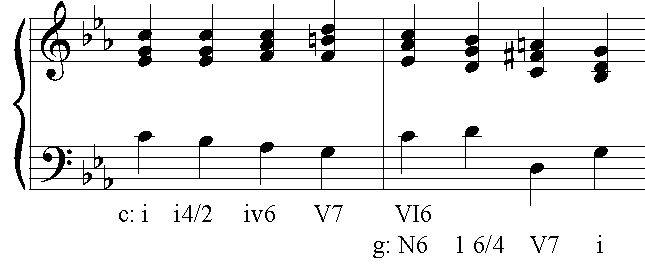
The Neapolitan chord
What this chord does: The Neapolitan is a pre-dominant chord. It is derived from the diminished iio chord in minor, by lowering the root.
How it is spelled: The Neapolitan is a major triad built on the lowered second scale degree; therefore it consists of these scale degrees: lowered 2, 4, and the low 6. (Musicians often say "flat two, four, and flat six" even though in every key, the notes don't literally have flats on them.)
In a minor key, the sixth scale degree is already low, so it requires no alteration; only the 2nd scale degree needs to be lowered. In major, the Neapolitan chord requires both the 2nd and 6th scale degrees to be lowered, which makes this chord more chromatic in the major mode, and a bit more surprising to the ear.
How it is indicated in musical analysis: This chord is usually indicated by the letter N, and if in first inversion as N6, which is the most common usage. Some theory texts indicate this chord as bII (“flat II”). When you see the lowered 2nd scale degree in a pre-dominant chord at a cadence, it may be a Neapolitan. Analyze to determine if it is indeed a major triad built on that note.
How it sounds: Since this chord is a major triad, its sound is not dissonant. But because of its unusual half step root relationship to the tonic, the diminished third interval created as it resolves, and the tritone root movement to its chord of resolution (the V), it can sound quite striking. It is not the quality of the chord, but rather the relationship of the chord to the tonality that gives this chord its unexpected character.
How it is used and resolves: The Neapolitan in its most classic use is in first inversion and resolves to V (the tonic six-four may intervene).
There are a few important things to remember: double the third, as it is a primary tone and is not an altered tone; place the b2 scale degree in the soprano or alto voice. However, there is one quite unusual feature of this chord’s resolution: the lowered second scale degree always moves down to the leading tone, a diminished third below. (If the tonic six four intervenes, the lowered 2nd moves through the tonic note on its way to the leading tone.) Here is an example of the N6 chord in the key of b minor:

This voice movement from flat 2 to leading tone is odd, since we usually make chromatic movement in the same voice. Even though the V chord contains the 2nd scale degree, we do not move the lowered 2nd degree up to the regular 2nd scale degree; it always moves to the leading tone instead. This is the most important thing to remember about the voice leading of this chord, and the first thing to take care of when resolving it. Once this note is resolved, it will be much more clear where the other voices should go.
Since the Neapolitan usually resolves to V, it is not typically found in root position, since that would create a tritone leap in the bass from flat 2 to the dominant note. Most often, the third of the N chord (the 4th scale degree) is in the bass. The chord is approached like any ii chord, often using common root movements of up a 4th (by approaching from VI), down a 3rd (by approaching from IV), or up a step (approaching from the tonic chord.)
[Note: moving up a 4th, down a 3rd and up one step are the three types of root movement that are most common in musical progressions. These are not the bass notes, but rather the distance from one Roman numeral to the next. For example ii6 – V is an up a 4th root movement. You may wish to visit the tutorial on typical root movement if you have not analyzed music this way before.]
Doubling: As you may know, chromatic notes should not be doubled, and primary tones are good notes to double. Therefore, the fourth scale degree is usually doubled in this chord, which is the third of the triad, since it is both a primary tone and in major keys is the only non-chromatic note. Rarely, the root may be doubled, but this occurs infrequently, typically only when this chord is being tonicized.
Tonicizing the Neapolitan: Since the N is a major triad, it can be tonicized. (The V of N happens to be the triad VI in the minor mode.) When a secondary dominant resolves to a root position N chord, the root of the N may be doubled – this will mean the lowered 2nd scale degree in the bass will leap a tritone when resolving to V while the other lowered 2nd scale degree doubled above will move to the leading tone as required, as in the example below.

Using a Neapolitan 6th chord as a pivot chord in modulation:
A Neapolitan chord is useful as a pivot chord in modulation. Since it is a major triad, there are many diatonic and even chromatic functions that can interchange with the Neapolitan function for use as a pivot chord. Using a Neapolitan chord as a pivot allows you to make both close and distant modulations. There are too many possible modulations to discuss them all, but essentially they work the same: either the N in the old key or N in the new key can be used as the pivot chord.
For example, one could modulate from I to iii, D to f# min, if the IV chord in D major (a G major triad) was used as a pivot. This chord will function as the Neapolitan in the key of F# minor. This is an example of a closely related key modulation. For a more distant example, the N chord in E major (an F major triad) could become I of the new key, to modulate to F major, which is a half step modulation, quite a distance away on the circle of fifths.
[Note: If you compare the distance between the roots of the two chord functions being used in your analysis for the pivot chord, this will always indicate the distance of the modulation. For example, if the pivot is IV in the one key, and N in the other, the modulation will be a major third, since the distance between the roots of IV and N are a major third apart. Whether the modulation goes up a M3 or down a M3 will depend on whether the IV is in the original key and N in the new, or vice versa. If this way of analyzing pivot chords is new to you, you may wish to visit the tutorial about how to easily find a pivot chord to modulate to any key.]
Here is one example of a modulation using a N as a pivot. This is a modulation to a closely related key, from a minor tonic to the minor dominant (i to v), using the VI in the original key as the pivot, which is N in the new key.

To verify that you understand the main principles of the Neapolitan chord, be sure you can answer the following questions:
What scale degrees make up the N chord?
To what chord does the N resolve?
What is the most important voice leading principle when resolving a Neapolitan chord?
What note is usually doubled in the N chord?
If you have trouble with any of these questions, review the appropriate sections above.
| 